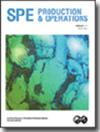用实验方法改进螺旋井下气油分离器的性能
IF 1.4
4区 工程技术
Q2 ENGINEERING, PETROLEUM
引用次数: 3
摘要
对在低压井中进行人工举升的地下泵应用的日益增长的需求增加了高效井下分离器的必要性,以防止气体进入泵中。本研究的目的是实证研究螺旋井下分离器的效率,并为提高其性能提供建议。为了使结果更加实用,使用量纲分析和白金汉定理指定了控制问题的无量纲数,并建立了实验室规模的分离器。选择油和空气作为本实验的工作流体。实验结果表明,分离器的性能分为三个区域:低效区、快速生长区和非生长区。为了提高分离器的效率,通过堵塞内管的初始孔来改进分离器,以提供一个区域来发展预旋效应。改进后的分离器显示出高达7%的效率提高。在第三步骤中,在第一修改中在入口区域堵塞的孔的数量分布在内管的其余部分中,使得总孔面积保持恒定。在这种情况下,分离器的效率与前两种情况相比显著提高了两倍之多。研究发现,分离器的入口设计对其性能有很大影响。本文章由计算机程序翻译,如有差异,请以英文原文为准。
Performance Improvement of Helical Downhole Gas-Oil Separator Using Experimental Approach
Growing demand for a subsurface pump application to perform artificial lift in low-pressure wells increases the necessity of a high-efficiency downhole separator to prevent gas entrance in the pump. The purpose of this study is to empirically investigate the efficiency of a helical downhole separator and provide suggestions for improving its performance. To make the results more practical, dimensionless numbers governing the problem were specified using dimensional analysis and the Buckingham theorem, and a laboratory-scale separator was built. Oil and air were selected as the working fluids for this experiment. The results of the experiments showed that the separator performance was divided into three regions: inefficiency region, rapid-growth region, and nongrowth region. To increase the separator efficiency, the separator was modified by blocking the initial holes of the inner tube to provide a region for developing the prerotational effect. The modified separator showed an increase in efficiency as much as 7%. In the third step, the number of holes that were blocked at the entrance region in the first modification were distributed in the rest of the inner tube so that the total hole area remains constant. The separator efficiency, in this case, was significantly increased compared with the previous two cases by as much as twofold. It was found that the inlet design of the separator significantly affects its performance.
求助全文
通过发布文献求助,成功后即可免费获取论文全文。
去求助
来源期刊

Spe Production & Operations
工程技术-工程:石油
CiteScore
3.70
自引率
8.30%
发文量
54
审稿时长
3 months
期刊介绍:
SPE Production & Operations includes papers on production operations, artificial lift, downhole equipment, formation damage control, multiphase flow, workovers, stimulation, facility design and operations, water treatment, project management, construction methods and equipment, and related PFC systems and emerging technologies.
 求助内容:
求助内容: 应助结果提醒方式:
应助结果提醒方式:


